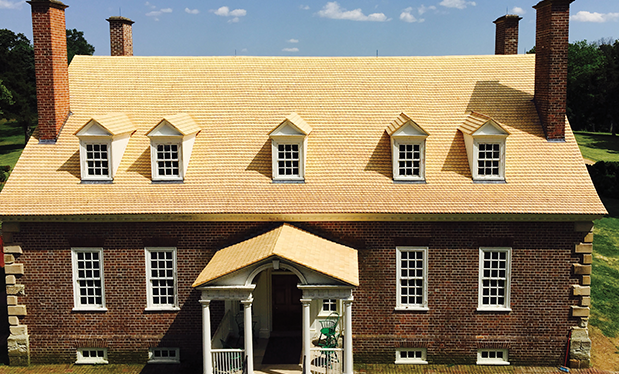In the U.S., various types, classes and grades of rigid board, faced, polyisocyanurate insulation are used as components of low-slope roof systems. The NRCA Roofing Manual: Membrane Roof Systems—2015 provides NRCA's best practice guidelines for using specific polyisocyanurate insulation products in membrane roof systems. Following is an overview of some of these guidelines.
ASTM C1289
The U.S. product standard for rigid board, faced, polyisocyanurate insulation is ASTM C1289-16a, "Standard Specification for Faced Rigid Cellular Polyisocyanurate Thermal Insulation Board." ASTM C1289 addresses 18 products. Within ASTM C1289, types, classes and grades differentiate various products.
NRCA recommends roof system designers use the complete ASTM C1289 designation (including type, class and grade) to clearly delineate the specific product intended.
R-value
ASTM C1289 requires polyisocyanurate insulation be tested and found to have the minimum thermal resistances (R-values) provided in ASTM C1289's Table 2—Thermal Resistance Properties. Also, product (board) or package marking must bear the product's tested R-value.
Instead of using R-value, U.S. polyisocyanurate insulation manufacturers are going to market using the long-term thermal resistance (LTTR) method for identifying polyisocyanurate insulation thermal resistance properties.
NRCA recommends designers specifying polyisocyanurate insulation determine roof system thermal resistance using an in-service R-value of 5.0 per inch. In NRCA's opinion, this design in-service R-value more closely represents conditions in the built environment than LTTR or tested R-value.
In addition to design in-service R-value, NRCA recommends designers specify polyisocyanurate insulation by its desired thickness and not LTTR or R-value to avoid possible confusion.
Application-specific guidance
Polyisocyanurate insulation is available in 4- by 4- and 4- by 8-foot board sizes. NRCA recommends roof system designers specify a maximum 4- by 4-foot board size for polyisocyanurate adhered to a substrate. The 4- by 8-foot size is appropriate for loosely laid and mechanically attached applications.
Available thicknesses range from 1 to 4 inches thick. When using flatstock polyisocyanurate insulation, NRCA recommends designers specify polyisocyanurate insulation be installed in multiple layers with a 1 1/2-inch minimum and 2 1/2-inch maximum thickness per layer.
Furthermore, NRCA recommends designers specify polyisocyanurate insulation be manufactured to have a minimum 20-psi compressive strength (Grades 2 or 3) and have facers that are compatible with the assembly method and other roof assembly components.
ASTM C1289, Type I (foil facers) products generally are used in wall sheathing applications and, because of their facers and compressive strengths, they are not considered to be appropriate for roofing applications.
ASTM C1289, Type II generally designates products appropriate for roofing applications. Type II, Class 1 (reinforced cellulosic mat facer) products may be suitable with all roof system types. NRCA recommends Type II, Class 2 (coated glass facer) products be used with single-ply membrane roof systems using water-based bonding adhesives. Type II, Class 3 (uncoated glass facer) products may be suitable with hot-applied built-up and polymer-modified bitumen roof systems. Type II also has a Class 4 that designates high-density polyisocyanurate panels intended for use as roof insulation cover boards at a maximum thickness of 1/2 of an inch.
ASTM C1289 also includes four additional product types (Type III, Type IV, Type V and Type VII) to address polyisocyanurate insulation-based composite board products.
NRCA recommends designers specify the use of a suitable cover board layer over polyisocyanurate insulation before roof membrane installation.
Additional information regarding using polyisocyanurate insulation in membrane roof systems is provided in The NRCA Roofing Manual: Membrane Roof Systems—2015's Chapter 4—Rigid Board Insulation, Section 4.9—Polyisocyanurate.
Mark S. Graham is NRCA's vice president of technical services.



